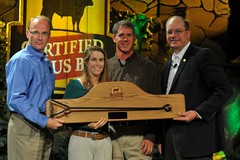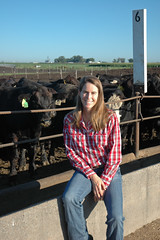My oldest daughter came home from school one day a couple of years ago and announced that one of her friends was going to stop eating meat and become a vegetarian. I asked her, “Why?”, and she responded, “I don’t know—she said that she wanted to stop using/eating products that were made from animals.” I am always looking for ways to broaden my children’s horizons and increase their knowledge, and this seemed to be a great opportunity so I ran with it…
I asked my daughter if she realized that the car that we were driving in would not operate without cattle by-products…I then asked her if she realized that the road that we were driving on was made from asphalt that contains a binding agent made from beef fat…I then asked her if she realized that the soap that she had used the night before to shower with was made in part with beef fat and protein…

The shoes on her feet and the basketball in her hand were both made from cow hide leather...The muscles in her arms are fueled by beef!
The car got really quiet so I kept rattling off common travel, household, textile, food and pharmaceutical products that all contained some by-product from cattle. I believe that I rendered her speechless (which is no small feat given that this child is both incredibly intelligent and also going through the teenage stage of being omniscient). Apparently, it had never occurred to her that so many products other than beef came from cattle…
The reality is that 98% of the beef animal is used to make products that we all rely on. Many of those are products other than the great tasting beef that we all normally associate with cattle! I would like to share some of the other products that are made from cattle. These products are made from the stuff that is left over after the beef muscle cuts are taken out…
Pharmaceuticals
*blood factors (for treating hemophilia, killing viruses, and making anti-rejection drugs)
*Chymotrypsin (promotes the healing of wounds)
*Collagen (used in plastic surgery and to make non-stick bandages)
*Cortisol (anti-inflammatory)
*Glucagon (treats hypoglycemia or low blood sugar)
*Heparin (anticoagulant used to treat blood clots)
*Insulin (for treating diabetes or high blood sugar)
*Pancreatin (aids in digestion of food)
*Thrombin (coagulant which helps blood to clot)
*Vasopressin (controls intestinal and renal functions)
*Vitamin B-12 (prevention of B-complex deficiencies)
Food
Gelatin comes from the connective tissue of cattle and is used to make many non-beef food items such as: candies, dairy products, deserts, diet products and jellies.
Household Products
*Candles *Ceramics *Cosmetics *Crayons
*Deodorants *Detergents *Floor Wax *Insecticides
*Insulation *Linoleum *Mouthwash *Paints
*Paper *Perfume *Plastic *Shaving Cream
*Soaps *Synthetic Rubber *Toothpaste *Car Polish and Wax
Textiles/Apparel
Cowhide Leather!–Which is used to make clothing, shoes, boots, belts, purses, wallets, gloves, luggage and upholstery for cars and furniture, and sports balls.
Travel
*Antifreeze (contains glycerol which is derived from beef fat)…
*Asphalt (contains a binding agent made from beef fat)…
*Beef Fats and Proteins are used to make: auto and jet lubricants, outboard engine oil, high performance greases, and brake fluid…
*Glue from beef protein is used in automobile bodies…
*Tires have stearic acid which allows rubber to hold its shape…

Cattle are not only great recyclers converting non-edible feedstuffs into great tasting beef, but they are also highly diverse in the products that they offer to us.
Thanks to the American National CattleWomen for providing the information listed above which helps us to have a better appreciation for all of the products that cattle give to us…
This post wraps up my environmental theme series…Thursday’s post will start a new series about how a diet rich in beef can play a key role in good health…By the way, nothing says Happy Valentine’s Day like a great tasting steak!











Bravo! We teach this at every opportunity! We started at a simple level with 3 and 4 year olds from our kids preschool class. And we make it a regular part of the curriculum for our 5-7 yr old 4H Clovers. We assembled a basket with examples of by-products (from cattle, pigs, goats and sheep)that the kids recognize from everyday use. And they are so surprised by some of them! (as are the parents). It’s all about educating the public.
Thank you. I neverrealized so much came from a cow besides milk and meat.
I had no idea of all these by products from cattle. Thanks for the education!
Wow. So that means all of these products are made from a renewable resource. Much more environmentally friendly than synthesizing them from petroleum.
Excellent article. I think everyone in agriculture needs to be an ambassador for the industry, and take every opportunity you can to educate someone (child or an adult) I spent an entire flight “educating” a very nice, but naive, lady from the NE U.S. that told me “that the way farmers take care of animals on those factory farms is deplorable”. I would like to think think I made an impression that “while there are some areas to improve….99% of producers take care of their animals very well, and are good stewards of the land”
Pingback: The Contributions of a Cow « The Rancher's Daughter
Pingback: The Psychologist… | Feed Yard Foodie
Pingback: Romancing the Feed Yard… | Feed Yard Foodie
Remarkable……thanks it’s something to learn more about……
Pingback: Gettin’ Our Poop in a Group… | Feed Yard Foodie
Pingback: The Gift… | Feed Yard Foodie
Pingback: Greener Pastures… | Feed Yard Foodie
Absolutely wonderful article. This is what Nextdoor needs to relaying. Useful information that debunks myths.
Wonderful article! Thanks for posting and I hope you also re-post on Facebook and any other media form.